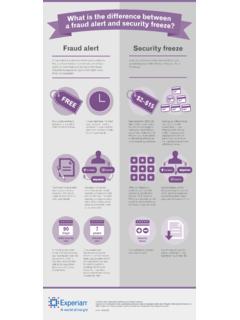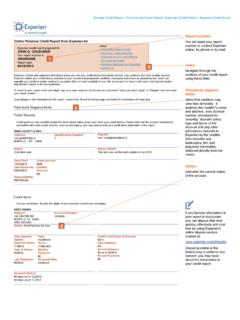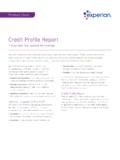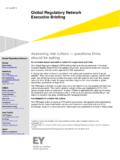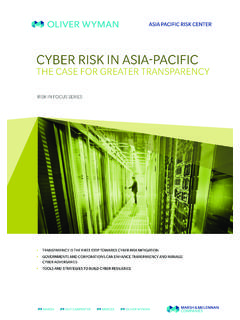Transcription of Managing Insider Risk through Training & Culture
1 Managing Insider Risk through Training & Culture ponemon institute Research Report Sponsored by Experian Data Breach Resolution Independently conducted by ponemon institute LLC Publication Date: May 2016 ponemon institute Research Report Page 1 Managing Insider Risk through Training & Culture ponemon institute , May 2016 Part 1. Executive summary Employees and other insiders inadvertently exposing sensitive or confidential information is a nightmare scenario for companies. Managing Insider Risk through Training & Culture , sponsored by Experian Data Breach Resolution, reveals why this security risk persists, despite millions of dollars spent on investments in employee Training and other efforts to reduce careless behavior in the handling of sensitive and confidential information. ponemon institute surveyed 601 individuals in companies that have a data protection and privacy Training (DPPT) program and who are knowledgeable about the program.
2 Companies understand the risk Sixty-six percent of respondents admit employees are the weakest link in their efforts to create a strong security posture. As shown in Figure 1, 55 percent of respondents say their organization had a security incident or data breach due to a malicious or negligent employee. The top two Insider risks , according to respondents, are a data breach caused by a careless or negligent employee who exposes sensitive information or succumbs to a targeted phishing attack. Companies also understand that security risks involve behaviors that could lead to a data breach or other security incident. These concerns are: Unleashing malware from an insecure website or mobile device Succumbing to targeted phishing attacks Using unapproved cloud or mobile applications to send sensitive company information Current state of employee security awareness Awareness of the Insider risk, however, is not influencing many companies represented in this study to put practices in place that will improve the security Culture and Training of employees.
3 Only 35 percent of respondents say senior executives believe it is a priority that employees are knowledgeable about how data security risks affect their organizations. As a result, 60 percent of respondents believe employees are not knowledgeable or have no knowledge of the company s security risks . Employee Training programs falling short While every company surveyed has a Training program, many of these programs do not have the depth and breadth of content to drive significant behavioral changes and reduce the Insider risk. Only half of the companies agree or strongly agree that current employee Training actually reduces noncompliant behaviors. Forty-three percent of respondents say that Training consists of only one basic course for all employees. These basic courses often do not provide Training on the risks that lead to data breaches. The following are critical areas that are often ignored: Figure 1. Did your organization have a security incident or data breach due to a malicious or negligent employee?
4 ponemon institute Research Report Page 2 Less than half (49 percent of respondents) say the course includes phishing and social engineering attacks Only 38 percent of respondents say the course includes mobile device security Only 29 percent of respondents say the course includes the secure use of cloud services Further, only 45 percent of respondents say their organizations make Training mandatory for all employees. Even when mandatory, exceptions are made for certain individuals. Specifically, 29 percent of respondents say the CEO and C-level executives in their companies are not required to take the course. Not only does this set a poor example for other employees, it puts high value and sensitive information at risk due to the potential carelessness of senior executives. Conclusion: Creating a Culture of security Mitigating the Insider risk should include both Culture and Training . Sixty-seven percent of respondents say their organizations do not provide incentives to employees for being proactive in protecting sensitive information or reporting potential issues.
5 Only 19 percent of respondents say their organizations provide a financial reward and 29 percent of respondents say they include such information in performance reviews. Another approach to changing behavior is to have clear consequences for negligent behavior. Unfortunately, the survey found that one-third of respondents say there are no consequences if an employee is found to be negligent or responsible for causing a data breach. The most common type of follow-up with the employee is a one-on-one meeting with a superior. Only 16 percent of respondents say the employee s salary would be reduced and 33 percent say the employee would be terminated. In conjunction with Culture , DPPT programs are critical to reducing the Insider risk. Programs should have content that addresses the security risks facing the organization. Following are two recommendations that will improve both Training and Culture . Training . Gamify Training to make learning about potential security and privacy threats fun.
6 Interactive games that illustrate threats for employees can make the educational experience enjoyable and the content easier to retain. For example, new technologies that simulate real phishing emails and provide simple ways to report potentially fraudulent messages are gaining traction. These types of real-time and interactive activities can be effective in changing user behavior. Culture . Apply the carrot and stick approach to reducing the Insider risk. Provide employees with incentives to report security issues and safeguard confidential and sensitive information. Companies should establish and communicate the consequences of a data breach or security incident caused by negligent or careless behavior. The tone at the top is critical to strengthening an organization s security Culture . Senior executives should set an example by participating in the DPPT program and emphasizing the importance of reducing the risk of a data breach or security incident. Missing a valuable learning opportunity Following a data breach, companies have a unique opportunity to affirm through Training the importance of being conscientious when handling sensitive and confidential information as well as having a real example of the consequences of a data breach.
7 Unfortunately, 60 percent of companies do not require employees to retake security Training courses following a data breach, missing a key opportunity to emphasize security best practices. ponemon institute Research Report Page 3 Part 2. Key findings In this section, we provide an analysis of the key findings. The complete audited findings are presented in the appendix of the report. We have organized the report according to these topics: Insider risk & data breaches Organizational Culture & Insider risk Training programs & technologies to reduce Insider risk Insider risk & data breaches The number one security risk is employee carelessness. We asked respondents to rank their concern regarding six security risks . As shown in Figure 2, the number one concern is employees inadvertently exposing sensitive or confidential information followed by spear phishing and DDoS attacks. Figure 2. Which security risks are you most concerned about? 1 = most concern to 6 = least concern Web-centric attacks Malicious insiders Malware infections DDoS attacks Spear phishing Employees inadvertently exposing sensitive or confidential information ponemon institute Research Report Page 4 According to Figure 3, the negligent and malicious behaviors companies are most concerned about are: unleashing malware from an insecure website or mobile device (70 percent of respondents), violating access rights ( using someone else s authentication or password) (60 percent of respondents), using an unapproved mobile device in the workplace (55 percent of respondents) and using unapproved cloud or mobile apps in the workplace (54 percent of respondents).
8 Figure 3. Negligent and malicious behaviors of most concern to organizations More than one choice permitted 4% 17% 19% 21% 26% 39% 39% 47% 49% 54% 55% 60% 70% 0% 10% 20% 30% 40% 50% 60% 70% 80% Other Violating the company s data hygiene and/or clean desk policy Using a Web email account to move or share company data Jailbreaking mobile device Succumbing to social engineering Losing a laptop, tablet, smartphone or USB memory stick containing company data Downloading insecure apps Succumbing to a phishing attack Accessing company applications from an insecure public network (Wi-Fi) Using unapproved cloud or mobile apps in the workplace Using unapproved mobile device in the workplace Violating access rights Unleashing malware from an insecure website or mobile device ponemon institute Research Report Page 5 The majority of companies have had a data breach due to a malicious or negligent employee. As discussed, 55 percent of respondents say an Insider caused a security incident or data breach.
9 The two primary reasons for not being able to reduce the risk of a data breach are the lack of in-house expertise and a lack of leadership or ownership to address this risk (70 percent and 55 percent of respondents, respectively). Figure 4. Why reducing the risk of a data breach due to negligent or malicious employees is difficult More than one response permitted Organizational Culture & the Insider risk Senior management does not make privacy and security Training a priority. As shown in Figure 5, only 35 percent of respondents say senior management believes it is a priority that employees are knowledgeable about how data security risks affect their organization. Further, only 40 percent of respondents say the organization holds employees accountable for making sure they do not put sensitive and confidential data at risk. Almost half (49 percent of respondents) do agree that a strong security posture is part of the corporate Culture . Figure 5. What senior management thinks about the Insider risk Strongly agree and agree responses combined 2% 17% 29% 47% 50% 55% 70% 0% 10% 20% 30% 40% 50% 60% 70% 80% Other Training priorities Employee Training fatigue Lack of C-level buy-in or sponsorship Insufficient budget Organizational silos and turf issues Lack of leadership/ownership Lack of in-house expertise 35% 40% 49% 0% 10% 20% 30% 40% 50% 60% Senior executives believe it is a priority that employees are knowledgeable about how data security risks affect their organization Employees are held accountable for making sure they do not put sensitive and confidential data at risk A strong security posture is part of the corporate Culture ponemon institute Research Report Page 6 The departments most conscientious about safeguarding sensitive information are finance and accounting and compliance.
10 Respondents consider certain departments more careful than others in the handling of sensitive and confidential information. As shown in Figure 6, the most conscientious are: finance and accounting (69 percent of respondents), compliance (67 percent of respondents), legal (60 percent of respondents), human resources (59 percent of respondents) and internal audit (53 percent of respondents). The least conscientious are: sales, marketing and communications (8 percent of respondents, 6 percent of respondents and 5 percent of respondents, respectively). Figure 6. Which departments are most conscientious about protecting your organization s sensitive and confidential information? Five choices permitted 14% 5% 5% 6% 8% 9% 11% 13% 13% 23% 36% 49% 53% 59% 60% 67% 69% 0% 10% 20% 30% 40% 50% 60% 70% 80% None of the above Other Communications Marketing Sales/revenue management Records management General management Customer services Logistics Procurement Information technology (IT) Research Internal audit Human resources Legal Compliance Finance and accounting ponemon institute Research Report Page 7 How do organizations address negligent employees or reward good behavior?
